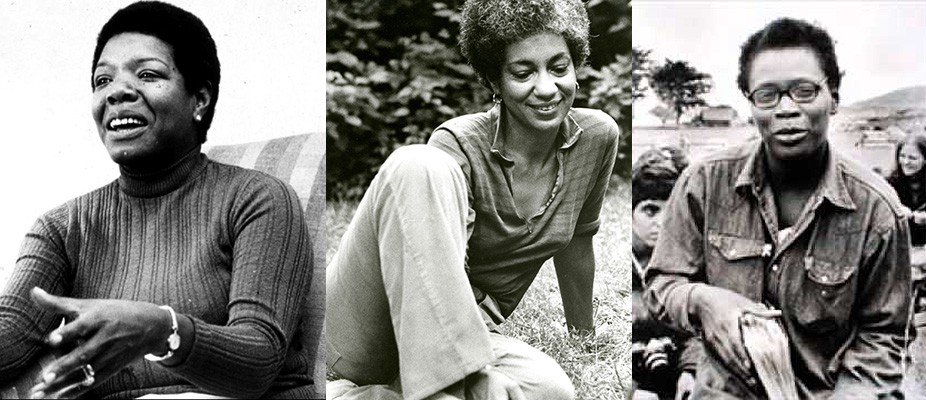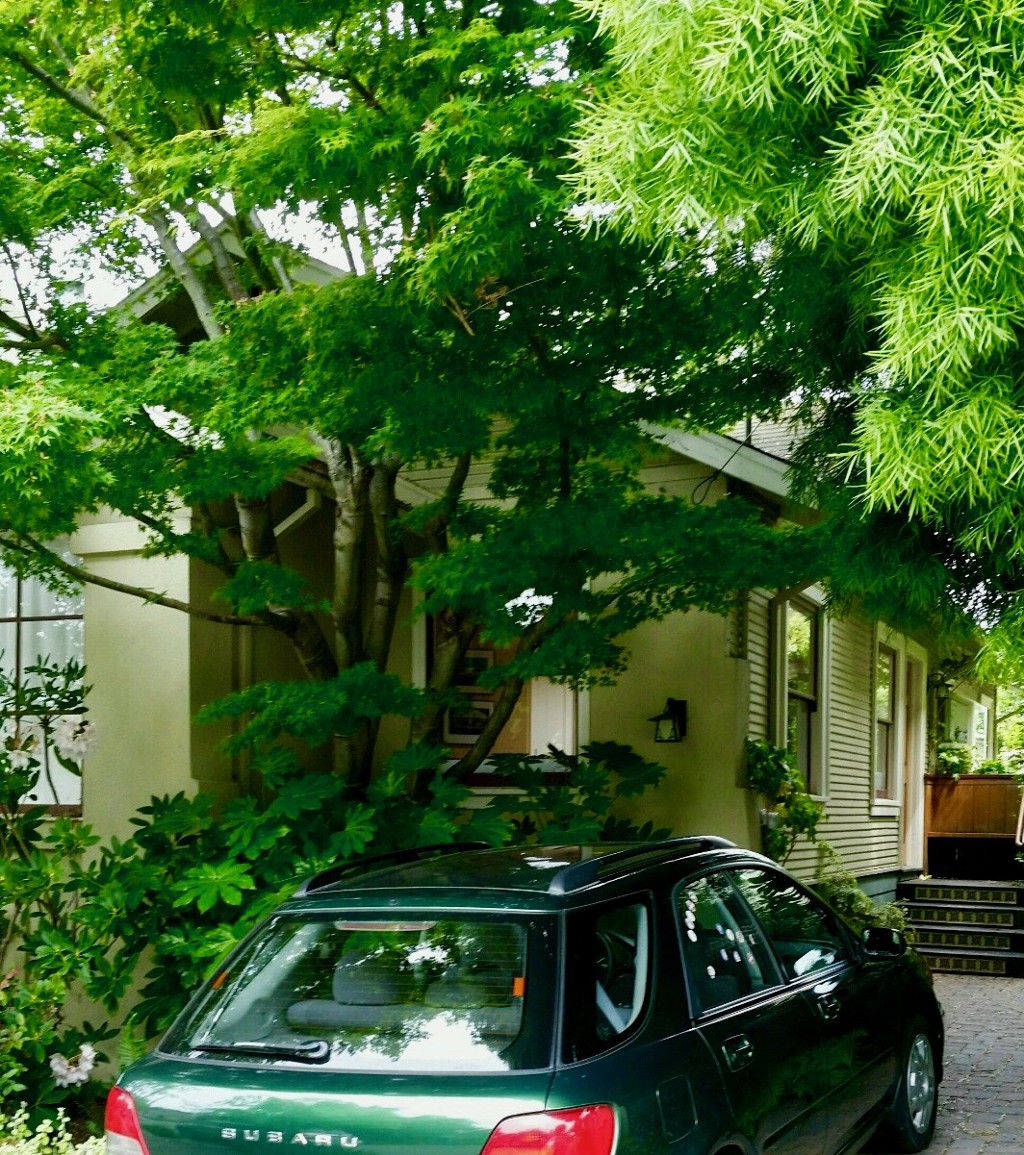Craft
Walking the East Bay in the Footsteps of Maya Angelou, June Jordan & Pat Parker
Finding new meaning in the haunts of poetry’s icons

Going through old paperwork from visiting writers at the Poetry Center and American Poetry Archives — at director Steve Dickison’s suggestion — revealed some interesting stuff. There were 8×10 headshots, newspaper clippings, and Pat Parker’s typewriter-typed resume; I read handwritten notes from Ai, Jayne Cortez, and one note from June Jordan about battling breast cancer. There’s a memorandum June sent in 1976, dated August 18th, that begins:
To: Everyone empowered to bring poetry into the environment that depends upon her commitment to that art
From: The Black Woman Poet, June Jordan
Audre Lorde sent a letter on her own monogrammed stationary, and there was a photo of Gwendolyn Brooks taken by Jewelle Gomez. Maya Angelou sent the Center a galley copy of Just Give Me a Cool Drink of Water. And there were addresses. Maya lived in Berkeley in the 70s, Pat Parker lived and worked in the East Bay, and June at one point was living on 8th Avenue in Brooklyn and then moved to Berkeley in the late 80s to teach at UC. I realized that I could go to these places.
Maya Angelou sent the Center a galley copy of Just Give Me a Cool Drink of Water. And there were addresses.
Two summers ago, while a poet-in-residence at the Juniper Summer Writing Institute, I was invited to write in Emily Dickinson’s bedroom. The room was bare, with the exception of a dresser and a desk and chair. Behind a roped area, I sat for an hour, writing whatever came from my stream of consciousness. In her room, Emily became more than her words; I understood her as a body that shaped and was shaped by spaces she inhabited. Now, I could do a similar thing with these poets. Luckily, my doctor’s appointment that following week put me a block away from the Oakland Women’s Health Center that Pat Parker resigned from in 1986.
It is no longer there. There are now offices for an internist, chiropractor, and naturopath, and across the street is my old therapist’s office. I went there weekly to work out the aftershocks of my Saturn Return and the anxieties of living 3,000 miles from home. Then I didn’t know I was a stone’s throw away from the workplace of the poet whose “wit and challenge” Pamela Sneed says she hears in my poetry. I didn’t know much about Pat Parker. But her name was familiar. She often appeared in anthologies with Audre Lorde, Cheryl Clarke, and June Jordan. She was a dyke poet.
In 2014, a few other poets/artists and I were invited to read Parker’s “Movement in Black” at a gathering for Older Lesbians Organizing for Change. I sat outside of 2930 McClure Street, eating a BLT and reading aloud the poem to passersby:
Movement in Black
Movement in Black
Can’t keep em back
Movement in Black.
Vickie Randle, who knew Pat personally and had an original copy of the poem with notes from when they would perform the piece, said that Parker asked, wherever she went, for the organizer to gather black women to read this piece. And I understand the need to do this. I give readings and sometimes wonder where the folks who share my intersectional struggles are. Even though I sometimes skirt the idea of a target audience when I write, I do imagine myself, in all my external and internal qualities, to be that audience.
I am the Black woman
& I have been all over
up on platforms & stages
talking about freedom . . .
I go into the office building. For some reason I thought it would be an open area and a receptionist would greet me. Instead there were three floors, with five doors on each level. On my way out, a woman who works behind one of those doors comes in and I inform her that a famous poet used to work here in the 80s. At that moment, I wished I made a copy of a poem to give her. She knows nothing about the Women’s Health Center, says the owner Dr. Tufts would know, but the doctor isn’t in.
It’s interesting to go where the poet once lived, and not their final resting place. In these spaces is where they lived, where they were in routines that defined their living. Like at Dickinson’s, I felt the dimensions of a space that held and influenced Pat — how it feels on my sides and the top of my head. These spaces are the (physical) forms and structures to their poetry.
I felt the dimensions of a space that held and influenced Pat. These spaces are the (physical) forms and structures to their poetry.
I get on the 18 bus that takes me to Solano and Colusa in Berkeley, walking distance from Maya and June’s former homes. Doing all this humanizes these poets — they are removed from their pedestals when I literally walk the same streets they’ve walked. I’m having a rooted experience of their poetry — it belongs to space and time, to people, to a constellation of exchanges and encounters that rooted them to this world. As the bus crosses the various ecotones that delineate neighborhoods and class, I wonder, what makes these poets different from me? The bus goes by Pegasus Bookstore on Shattuck, and when I recognize myself alongside them, as poet-to-poet, I see we are part of a poetic lineage. They have contributed to my presence in the now.
After being at Pat’s former employment with nothing to share, I make a detour. Solano Avenue has an assortment of businesses and I immediately spot a stationery store and figure they must have a photocopy machine. It is broken and the sales associate says I’m two blocks away from another one. It is six blocks, but I’m grateful to have writing to offer.
Colusa Street is lined with mature trees, there’s an elementary school where the children are in recess; the homes hide behind tall gates, and I feel I am being watched from curtains, from windows, from people who know their neighbors and I’m not one of them. I ask myself, Will you go to the door? Will you ring the bell? Will they know Maya Angelou?
I ask myself, Will you go to the door? Will you ring the bell? Will they know Maya Angelou?
She was the poet people exclaimed back at me when I said I wanted to be a poet. All the women, particularly my family members, had a line or two they would recited from “Phenomenal Woman.” Maya made things identifiable. And who didn’t know Maya after she read at Bill Clinton’s inauguration? My high school English teacher said that would be me one day. There was Maya’s “Still I Rise” recited by Alfre Woodard in the movie Beauty Shop — the women getting their hair did serenaded with celebratory words about their black womanhood, their will to survive, and their beauty. Angelou is easy on your spirits. When I listened to the 1971 audio recording of her reading from Just Give Me A Cool Drink of Water, enunciating each word like a machete cutting through sugar cane, I appreciated her dramatic voice and the music of her rhyme schemes, and understood why audiences loved her poetry. She was self-possessed and confident in her hereness.
I arrive at Angelou’s former residence and no one is home. The gate is in need of repair. One section leans to the side, and I peek into the opening it creates. There is a backyard, and surely Maya sat out there and wrote a poem or many. At the gate’s door, I leave five copies of “They Went Home”:
They went home and told their wives,
that never once in all their lives,
had they known a girl like me,
But . . . They went home.
They said my house was licking clean,
no word I spoke was ever mean,
I had an air of mystery,
But . . . They went home.
My praises were on all men’s lips,
they like my smile, my wit, my hips,
they’d spend one night or two or three,
But . . .

This is the first poem of Angelou’s I read over and over again from an anthology of women’s poetry from around the world. Ain’t I A Woman was a gift from my high school global studies teacher. On the photocopies of “They Went Home,” I write: “Happy National Poetry Month” on the top and “Maya Angelou lived here!” on the bottom. I leave a rock to keep the poems from blowing away, but also for the heaviness of the heart. This is what I was told as an exchange student in Israel. A group of us wanted to know why there were stones on the graves. As I walk from Maya’s gate, a breeze cools my face, and I grab a handful of gravel from a neighbor’s yard, walk back and pour more heart on her poems.
I leave a rock to keep the poems from blowing away, but also for the heaviness of the heart.
I go back to Solano, make a left, then a right, then walk for about 20 minutes to get to the home where June Jordan lived and died. I notice the ravens — on the phone lines, near the dumpsters, and atop a mailbox. At one point I pass a house that has an enclosed bookcase, hiked up on a pole. You can take a book, but need to leave one in exchange. Finally, I’m at the street that promises to deliver me to June. This neighborhood feels more alive than Maya’s old street, with a school, a church, shops in walking distance, and people in motion. I am excited to see a car parked in front of Jordan’s former home, and the lights are on in the kitchen, and I dare myself to knock.

I’m not sure what I will say, how to introduce myself really — Hi, my name is Arisa White and I’m a poet researching black poets in The Poetry Center Archives at San Francisco State University and I recently found out June Jordan lived here. Feels so wordy. I debate just leaving a copy of the essay “Finding the Way Home” on the front steps and letting it be a day. My first knock is tentative. My second knock has more presence to it. I want whoever is home to come answer.
My second knock has more presence to it. I want whoever was home to come answer.
Heather peeks through the side window with that “Who are you?” look on her face. I smile back, completely understanding that protectiveness you feel when a stranger arrives at your doorsteps. Heather opens the door, I introduce myself with a pared-down version of my rehearsed original, end it with: “Did you know June Jordan lived here?”
Indeed she knew and it was one of the pluses for purchasing the home from Chris, June’s son, in 2006. Heather invites me in and there I stand in June’s home. There were some renovations, the exterior used to be painted cornflower blue, and she points to the trumpet vines that run alongside the house and into the backyard. Heather tells me that Jordan wrote about the trumpet vines in the later years of her poetry.
Trumpet vine sneaks in
dressing up the window screen
tendrils wreck the wall
We go into the backyard, and Heather informs me that “June hosted salons.” They were quite memorable — the neighbor across the street still remembers them. June kept a lively home, and Heather’s former boss was often at those parties. This is the boss from the organization where Heather did environmental breast-cancer awareness, using June’s poetry to further illuminate the issue. She tells me that she keeps the place happening as well, which is one way she’s continuing Jordan’s legacy.
Heather excuses herself and goes back into the house to find a particular June poem, and the grass in the backyard is so green, even in my memory it remains emerald. She can’t locate it, and I have nothing more to ask or say, but I am grateful. I thank Heather for inviting me into her home and for sharing her stories. Before I go, I give her a copy of Jordan’s essay and leave my information just in case anything more comes to mind.
Heather and I have emailed each other a few times since; she has introduced me to her former boss Jeanne, and when I asked her what’s her favorite June Jordan poem, she wrote back to say, “Calling on All Silent Minorities”:
HEY
C’MON
COME OUT
WHEREVER YOU ARE
WE NEED TO HAVE THIS MEETING
AT THIS TREE
AIN’ EVEN BEEN
PLANTED
YET
I don’t have a favorite June Jordan poem yet, but this journey to her home was a gratifying way to find my way to one. I now own her collected poems. I’ve watched all the videos they have of her in the poetry archives, and this tour of poets’ spaces was an embodied way to honor the dead and find where they live on. This is how we meet them over and over again. How they stay breathing.
Black Women in the Archives, a digital collection, at The Poetry Center’s American Poetry Archives is now live.








